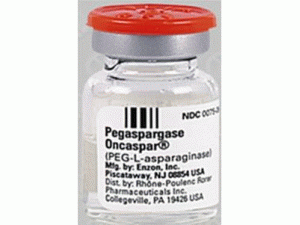 产地国家:美国
产地国家:美国
处方药:是
所属类别: 750单位/毫升 5毫升/瓶
包装规格: 750单位/毫升 5毫升/瓶
生产厂家英文名:SIGMA TAU PHARMACEUTICALS
原产地英文商品名:ONCASPAR 750U/ML 5ML VL DPSH 1/EA
原产地英文药品名:PEGASPARGASE
中文参考商品译名:昂卡司帕-750单位/毫升,5毫升/瓶
中文参考药品译名:培门冬酶
曾用名:NDC: 54482-0301-01
简介:
ONCASPAR是一种PEG化的L-门冬酰胺酶制剂。某些白血病细胞依赖于天门冬酰胺氨基酸存活,而L-门冬酰胺酶能够减少此种氨基酸。美国FDA于1994年2月批准本品用于治疗急性成淋巴细胞性白血病,在需要接受L-门冬酰胺酶治疗而又对天然L-门冬酰胺酶过敏的患者中使用。不但降低了免疫原性,而且用药更易为患者所接受——只需二周1次用药,而非重组的L-门冬酰胺酶需要一周2次用药。批准日期:1994年2月 公司:BAXALTA US INCONCASPAR(pegaspargase)注射液,用于肌肉注射或注射静脉使用美国最初批准:1994年最近的重大变化剂量和用法,推荐用量:01/2019剂量和给药,剂量修改:01/2019禁忌症:01/2019作用机制L-天冬酰胺酶是催化氨基酸L-天冬酰胺转化为天冬氨酸和氨的酶。认为ONCASPAR的药理学作用是基于由于血浆L-天冬酰胺的消耗而选择性杀死白血病细胞。具有低天冬酰胺合成酶表达的白血病细胞具有降低的合成L-天冬酰胺的能力,因此依赖于外源L-天冬酰胺来存活。
适应症和用法:ONCASPAR是一种天冬酰胺特异性酶,是一种多药物化学治疗方案的组成部分,用于治疗儿科和成人患者有:一线急性淋巴细胞白血病。急性淋巴细胞白血病和对天冬酰胺酶的超敏反应。
剂量和给药:肌肉注射或静脉注射不超过每14天一次。21岁及以下的患者:2,500国际单位/平方米。年龄超过21岁的患者:2,000国际单位/平方米。对于肌内注射,将单个注射部位的体积限制在2mL;如果大于2mL,请使用多次注射部位。对于静脉内给药,通过已经运行的输液,在100mL 0.9%氯化钠注射液,USP或5%葡萄糖注射液,USP中给予1至2小时的时间。如果药物已冷冻,在室温下储存超过48小时,或摇晃或剧烈搅动,请勿使用ONCASPAR。
剂量形式和强度:注射:单剂量小瓶中的3750国际单位/5mL(750InternationalUnits/mL)溶液。
禁忌症:对ONCASPAR的严重超敏反应的历史。先前L-天冬酰胺酶治疗严重血栓形成的病史。先前L-天冬酰胺酶治疗的胰腺炎病史。先前L-天冬酰胺酶治疗的严重出血事件的历史。严重的肝功能损害。
警告和注意事项:过敏反应或严重超敏反应:给药后1小时观察患者。停止严重超敏反应的患者的ONCASPAR。血栓形成:停止严重血栓事件患者的ONCASPAR。胰腺炎:评估腹痛患者胰腺炎。停止患者的ONCASPAR胰腺炎。葡萄糖不耐受:监测血糖。出血:停止ONCASPAR治疗严重或危及生命的出血。评估病因和治疗。肝毒性:通过从周期中恢复来监测毒性。
不良反应:最常见的(> 5%)3级不良反应包括低蛋白血症,升高的转氨酶,发热性中性粒细胞减少,高甘油三酯血症,高血糖,胆红素升高,胰腺炎,异常凝血研究,栓塞和血栓形成事件以及高敏感性。用于特定人群哺乳期:建议女性不要母乳喂养。
包装提供/存储和处理:ONCASPAR(pegaspargase)注射剂在I型单剂量小瓶中以无菌,透明,无色,无防腐剂的溶液形式提供,每5mL含有3,750国际单位的pegaspargase(750International Unitsper mL)溶液(NDC 0944-3810-01)。将ONCASPAR在2°C至8°C(36°F至46°F)的温度下冷藏在原装纸箱中,以防光照。 不要摇晃或冷冻产品。未开封的小瓶可以在室温(15°C至25°C [59°F至77°F])下储存超过48小时。
英文版说明书:
ONCASPAR 750U/ML 5ML VL DPSH 1/EA PEGASPARGASEBAXALTA US INC.00944-3810-01 $21,107.90 ONCASPAR (pegaspargase) is given to patients with acute lymphoblastic leukemia (ALL) as part of a group of chemotherapy medications. ONCASPAR is administered IM/IV* and should not be given more frequently than every 14 days.Indication and UsageONCASPAR (pegasapragase) is indicated as a component of multi-agent chemotherapeutic regimen for treatment of patients with:•First-line Acute Lymphoblastic Leukemia (ALL)•ALL and hypersensitivity to native forms of L-asparaginase.Detailed Important Safety InformationCONTRAINDICATIONS•History of serious allergic reactions to Oncaspar•History of serious thrombosis with prior L-asparaginase therapy•History of pancreatitis with prior L-asparaginase therapy•History of serious hemorrhagic events with prior L-asparaginase therapyWARNINGS and PRECAUTIONSAnaphylaxis and Hypersensitivity: Anaphylaxis or serious allergic reactions can occur; therefore, patients should be observed for one hour after administration. Discontinue ONCASPAR in patients with serious allergic reactions.Thrombotic Events: Serious thrombotic events, including sagittal sinus thrombosis can occur. Discontinue Oncaspar in patients with serious thrombotic eventsPancreatitis: Pancreatitis can occur. eva luate patients with abdominal pain for evidence of pancreatitis. Discontinue Oncaspar in patients with pancreatitisGlucose Intolerance: Glucose intolerance can occur. In some cases, glucose intolerance is irreversible. Monitor serum glucose.Coagulopathy: Increased prothrombin time, increased partial thromboplastin time, and hypofibrinogenemia can occur. Monitor coagulation parameters at baseline and periodically during and after treatment.Hepatotoxicity: Hepatotoxicity and abnormal liver function, can occur. Perform appropriate monitoring.ADVERSE REACTIONSThe most common adverse reactions with ONCASPAR (≥2%) are allergic reactions (including anaphylaxis), hyperglycemia, pancreatitis, central nervous system (CNS) thrombosis, coagulopathy, hyperbilirubinemia, and elevated transaminases.Hyperlipidemia (hypercholesterolemia and hypertriglyceridemia) has been reported in patients exposed to ONCASPAR.
